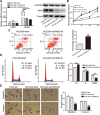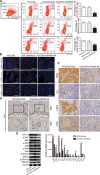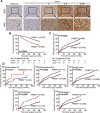PKM2 promotes metastasis by recruiting myeloid-derived suppressor cells and indicates poor prognosis for hepatocellular carcinoma
- PMID: 25514599
- PMCID: PMC4359260
- DOI: 10.18632/oncotarget.2749
PKM2 promotes metastasis by recruiting myeloid-derived suppressor cells and indicates poor prognosis for hepatocellular carcinoma
Abstract
Pyruvate kinase M2 (PKM2) is a member of the pyruvate kinase family. Recent work has defined the "non-metabolic" functions of PKM2. However, the role of PKM2 in HCC remains unclear. To investigate the role of PKM2 in tumor growth, invasion and the prognosis of hepatocellular carcinoma (HCC), PKM2 expression was measured in HCC cell lines and tissues using qRT-PCR, western blot, and immunofluorescence assays. In in vitro experiments, PKM2 was knocked down using a short hairpin RNA lentivirus vector, and tumor cell behavior and the downstream signaling pathways and chemokine were analyzed. For the analysis of in vivo tumor growth, intratumoral and peritumoral lymphocyte infiltration were examined in nude mice. The prognostic value of PKM2 was analyzed by immunohistochemistry in two cohorts including 721 HCC patients. Together, our data obtained from cell lines, tumorigenicity studies, and primary HCC samples illustrate an oncogenic role for PKM2 in tumors. Moreover, PKM2 may serve as a novel prognostic indicator for HCC patients after curative resection, targeted therapy aimed at PKM2 may represent an effective treatment approach for HCC.
Conflict of interest statement
Nothing to report.
Figures





Similar articles
-
Pyruvate kinase M2 prevents apoptosis via modulating Bim stability and associates with poor outcome in hepatocellular carcinoma.Oncotarget. 2015 Mar 30;6(9):6570-83. doi: 10.18632/oncotarget.3262. Oncotarget. 2015. PMID: 25788265 Free PMC article.
-
Switching of pyruvate kinase isoform L to M2 promotes metabolic reprogramming in hepatocarcinogenesis.PLoS One. 2014 Dec 26;9(12):e115036. doi: 10.1371/journal.pone.0115036. eCollection 2014. PLoS One. 2014. PMID: 25541689 Free PMC article.
-
Mechanisms of pyruvate kinase M2 isoform inhibits cell motility in hepatocellular carcinoma cells.World J Gastroenterol. 2015 Aug 14;21(30):9093-102. doi: 10.3748/wjg.v21.i30.9093. World J Gastroenterol. 2015. PMID: 26290635 Free PMC article.
-
Progress of Pyruvate Kinase M2 in Hepatocellular Carcinoma-Associated Signaling Pathway.Tissue Eng Part C Methods. 2025 Mar;31(3):101-107. doi: 10.1089/ten.tec.2024.0368. Tissue Eng Part C Methods. 2025. PMID: 40105913 Review.
-
The Role of Pyruvate Kinase M2 Posttranslational Modification in the Occurrence and Development of Hepatocellular Carcinoma.Cell Biochem Funct. 2024 Sep;42(7):e4125. doi: 10.1002/cbf.4125. Cell Biochem Funct. 2024. PMID: 39327771 Review.
Cited by
-
The gate to metastasis: key players in cancer cell intravasation.FEBS J. 2022 Aug;289(15):4336-4354. doi: 10.1111/febs.16046. Epub 2021 Jun 18. FEBS J. 2022. PMID: 34077633 Free PMC article. Review.
-
Scutellarin resensitizes oxaliplatin-resistant colorectal cancer cells to oxaliplatin treatment through inhibition of PKM2.Mol Ther Oncolytics. 2021 Mar 17;21:87-97. doi: 10.1016/j.omto.2021.03.010. eCollection 2021 Jun 25. Mol Ther Oncolytics. 2021. PMID: 33981825 Free PMC article.
-
Genetic and epigenetic aspects of initiation and progression of hepatocellular carcinoma.World J Gastroenterol. 2015 Oct 7;21(37):10584-97. doi: 10.3748/wjg.v21.i37.10584. World J Gastroenterol. 2015. PMID: 26457018 Free PMC article. Review.
-
Glucose Metabolism Intervention-Facilitated Nanomedicine Therapy.Int J Nanomedicine. 2022 Jun 17;17:2707-2731. doi: 10.2147/IJN.S364840. eCollection 2022. Int J Nanomedicine. 2022. PMID: 35747168 Free PMC article. Review.
-
Pyruvate Kinase M2: a Metabolic Bug in Re-Wiring the Tumor Microenvironment.Cancer Microenviron. 2019 Dec;12(2-3):149-167. doi: 10.1007/s12307-019-00226-0. Epub 2019 Jun 10. Cancer Microenviron. 2019. PMID: 31183810 Free PMC article. Review.
References
-
- Maluccio M, Covey A. Recent progress in understanding, diagnosing, and treating hepatocellular carcinoma. CA: a cancer journal for clinicians. 2012;62:394–399. - PubMed
-
- Hanahan D, Weinberg RA. Hallmarks of cancer: the next generation. Cell. 2011;144:646–674. - PubMed
-
- Warburg O. On the origin of cancer cells. Science. 1956;123:309–314. - PubMed
-
- Warburg O. On respiratory impairment in cancer cells. Science. 1956;124:269–270. - PubMed
Publication types
MeSH terms
Substances
LinkOut - more resources
Full Text Sources
Other Literature Sources
Medical
Molecular Biology Databases
Miscellaneous

